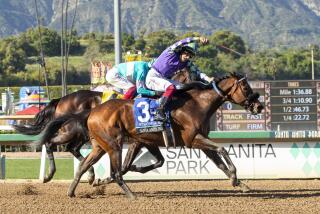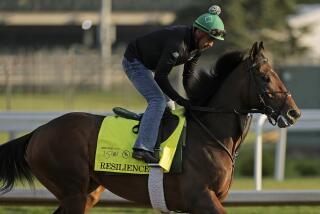Farming the Old-Fashioned Way--Draft Horses
The Tractor With Horse Sense --Advertisement for Ferrari tractors.
Thereâs never been a tractor that looks like Mike.
A 2,230-pound Belgian draft horse, Mike has all of the attributes of the star of a teen-age surf movie. His coat is that tawny shade that usually results from a summer on the sand. His white-blond mane falls in long wavelets over his brown eyes. And he has muscles.
In fact, some people claim Mike is as strong as a $30,000 piece of farm machinery.
When Mikeâs owner--Ontario dairyman Ted Koopman--was a boy, he drove a team of giant horses in the wheat fields of Alberta, Canada. When tractors eventually became widely available, work horses everywhere were taken off the job and reassigned to holiday hayride duty.
Two-Part Plan
Today, Koopman, 70, and others like him are behind a push to put draft horses (distinguished from standard horses by their size and the fringe of silky hair around their hoofs) back to work. Itâs a plan that is made of equal parts practicality and nostalgia.
âWith an inanimate object (a tractor), you pull out the key and it just sits there. I like working with horses because theyâre living, moving creatures,â said Robert Chilcott of Mira Loma. âWith a draft horse, if youâve got a pasture; if youâve got water and sunlight--youâve got power.
âThereâs been a substantial increase in the use of big horses in the last few years,â Chilcott added. âThey compete very well with a small tractor on an hourly basis. You canât drive a four-wheel-rive any faster than a horse can move when the groundâs rough. There are a lot of places to put a horse to work--collecting firewood, hauling logs and fencing. . . .â
Work Alongside Tractors
Draft horses can be seen working alongside tractors on asparagus farms in the Sacramento-Stockton delta area. A few Northern California ranchers use the horses to haul feed over snowy ground to their cattle in the winter. And because theyâre more maneuverable than a machine in heavily timbered areas, loggers sometimes put them to work dragging downed trees.
Chilcott is so proud of the work his draft horses do around the cattle ranch he owns in northeastern Arizona that he likes to show his animals off. Within the last five years, draft horse competitions--standard at county fairs up until the â30s--have been reintroduced at horse shows and fairs all over the country.
Chilcott was among the draft horse owners from several Western states who gathered at the Great Western Junior Livestock and Dairy Show at the Los Angeles County Fairgrounds last weekend. Though the show was primarily for competitors under age 18, the draft horse events were open to all ages.
Shortly before his horse, Ranger, was slated to compete, Chilcott braided the animalâs tail and clipped stray hairs with a pair of scissors. Chilcottâs wife, Janine, stood on a folding table at the horsesâs head, grooming Rangerâs mane.
Robert Chilcott, 60, is typical of modern work-horse devotees in that some of his fondest childhood memories are of draft horses. âIâll always remember that team we had when I was a kid,â he said. His family had a ranch on the east side of Cajon Pass. âIt was my job to hitch them up, then load pumpkins or haul hay with the wagon.â
There must be something exhilarating about being only 10 or 11 and watching a horse about 30 times your weight do your bidding. Even as adults, draft-horse fans seem awed by the fact that an animal so immense can be such an obliging co-worker and companion.
Cindy Fagan, 26, saw an ad for a draft horse for sale just after she moved onto property in Yorba Linda that came complete with a stable. âI decided that a draft horse had to be the ultimate horse,â said Fagan, an office manager who grew up in Pasadena and never worked a draft horse team as a child. She purchased Herbie, a 2-year-old Shire-Belgian cross (the five breeds of draft horses commonly found in this country are Shires, Belgians, Percherons, Suffolks and Clydesdales) and began riding him around town. âHe can do anything a normal horse can do,â Fagan said. âEverythingâs just a little exaggerated (when youâre riding him).â
âPushing 2,200 Poundsâ
Herbie grew larger than Fagan had expected, and now, at age 5, âhe eats almost double what a normal horse would eat, and heâs pushing 2,200 pounds and 17.2 hands,â she said. (A hand is fourinches; and a horseâs height is measured at the withers, the highest point of its back. A standard horse, in comparison, stands 16 hands or less and weighs about 1,000 pounds.) Itâs only because the beasts are so sweet-tempered that they make safe pets, she said.
So far, Fagan has been able to climb astride her horse without assistance, but Herbie wonât be full-grown for another year, she said.
Once a recreational rider or a farmer purchases a young work horse (they cost anywhere from $800 for an unregistered animal to as much as $40,000 for a top-of-the-line horse) they are likely to require help in breaking the animal. Fagan called on Harold Gabriel, a truck driver who operates Gabrielâs Shires and Driving Center in Chino. As well as breaking colts, he instructs team drivers and hires out and sells single horses and teams.
Gabriel, 39, started working with the big horses while he was still in grammar school. âMy grandfather, who was from Portugal, stuck with the horses when other people began using machinery just because he thought it was an easier way of doing things,â he said. âHe mowed hay, raked and hauled it with a wagon--like this one.â
Gabriel indicated the hay-filled farm wagon that he was busy rigging for competition. He said the wagon was about 140 years old and had belonged to his grandfather. Team owners who arenât lucky enough to have a farm wagon in the family can purchase them at annual draft horse and farm equipment auctions. There are also a handful of modern-day wagonsmiths in the country who make the wagons from new materials.
The harness, which hitches draft horse to wagon, isnât something you find at the corner tack shop. Gabriel ordered his from an Amish harness maker in Kansas. Since the Amish use draft horses and mules exclusively for farm labor, shunning modern machinery, Amish craftsmen are an excellent source of work-horse equipment. A majority of the draft-horse owners at Saturdayâs show were using Amish-made harnesses. Koopman had his harness set custom-made in Wyoming.
A working harness for a two-horse team costs Gabriel $1,500, he said. A show harness, made of patent leather, with brass and chrome trim, can cost as much as $3,000 for one horse, he said.
Impatient to Be Let Out
Zacariah, the Gabrielsâ Shire stallion, was harnessed and impatient to be let out of his stall and put through his paces before the judges. (Horses compete singly or in teams of up to six hitched to a single wagon. They are judged on such things as gait and appearance; and generally must show that they are valuable as workers.) To signal his anxiousness, Zacariah kicked once at the metal door of his stall. It commanded everyoneâs attention.


